Inside the shell of an defunct San Jose liquor store, Spec emerges from her back-room haunt, ready to explore. The black-and-grey-striped Maine Coon mix nervously eyes the clowder of new housemates, skulking a little closer each time before losing her nerve and scuttling back to the safety of a dark little corner.
“She’s still insecure,” says Marilyn Krieger, a widely renowned cat behaviorist and author who brands herself as “The Cat Coach.”
Krieger crouches to show how to lure a skittish kitty. Hunker down to “cat level,” she says, extend a finger and let the kitty creep up to impart its pheromones. “That’s her way of saying, ‘Nice to meet you,’” she explains, “while marking you at the same time.”
However, Spec is in no mood to introduce herself, even to a certified cat coach.
“She’ll work her way out eventually,” Krieger offers reassuringly.
“But you have to give her that freedom.”
Luckily for Spec and her 10 other cohabitants, the entire space was arranged with feline Feng Shui in mind, designed to ease the transition from shelter life at her own pace. Carpeted towers, cubbyholes, scratch posts, lots of vertical space to retreat to, kitty grass for digestion and plenty of catnip-spiked toys. Come Thursday, the sunny corner-store will open to the public as The Dancing Cat, San Jose’s first-ever cat café.
“Cats are so unique,” says Ann Chasson, who pulled the pop-up project together with her friend Mary Rubin to promote adoptions for Silicon Valley shelters. “This gives them a space for their personalities to emerge and a chance to bond with people in an environment that feels a lot like a home.”
Cat cafes originated in Taiwan and Japan as place for people who can’t own pets—for lack of space or lack of time—to commune with cats. Last year, the concept arrived stateside.
The Cat Town Café in Oakland, which opened last fall as an offshoot of an existing adoption agency, bills itself as the first permanent cat café in the United States. Proprietors say they can barely keep up with demand—a welcome problem, given the millions of strays that populate the Bay Area and overwhelm shelters. Japanese teahouse-inspired KitTea opened in San Francisco’s Hayes Valley last month with help from angel investors, a Petco grant and proceeds from a crowdfunding campaign.
Chasson and Rubin began mulling the idea of opening something similar in Silicon Valley last year, after striking up a friendship over a shared interest in fostering kittens. “At first I thought this would just be a fun thing to do,” says Chasson, who runs a biotech firm by day. “Then I realized that this could also become an important service to the community.”
Rather than soliciting donations, the pair pooled their own money for a month-long pilot to test whether the project could turn into something more permanent. They found a vacant liquor store on the corner of East Julian and North 15th streets via Craigslist and set to work decorating the space like a quaint little coffeehouse. Neighbors are thrilled to be rid of the liquor store, with its late hours and raucous if not sozzled patrons, and they’ve welcomed the entrepreneurial cat ladies.
“One of the neighbors from across the street—when I told him about our plans—asked me, ‘Can I give you a hug right now?’” Chasson says with a laugh. “Literally, we were welcomed with open arms.”
As a project manager for the city of San Jose’s public art program, Rubin also views The Dancing Cat as a way to activate downtown by way of tactical urbanism, working with local artists to promote a social cause.
Husband-and-wife artists Roan Victor and Sean Boyles, who own The Arsenal art supply store on The Alameda, were commissioned by the café to paint a series of expansive panels with paint-and-ink renderings of their own cats: Stretch, Mean Gene, Leeloo and Homes, depicted on their hind legs as though batting at cat toys.
“The city is really looking at how to create responsible development,” says Rubin, who oversaw Mineta San Jose International Airport’s widely acclaimed art installations. “This is an opportunity for community development, in that sense. And to get cats adopted.”
If the breakneck adoption rates at the Bay Area’s two other cat cafes are any indication, Rubin and Chasson will have to hustle to re-up on shelter cats. Carin Schroff, adoption coordinator for Town Cats, a no-kill shelter, hopes the low-key environment of a café will help some of the older, harder-to-adopt rescues finally find a human.
“Some of these cats get overlooked at a shelter,” Schroff says. Like Sophie, an 11-year-old orange-and-white Scottish Fold whose shyness has kept her a ward of the shelter for the better part of a decade. “This could give them a chance to shine.”
In addition to promoting adoptions, cat cafes seem to have finally found a way to create a physical gathering place for cat enthusiasts. Dog lovers have long had their dog parks, doggy Halloween parades and costume contests. But cats tend toward the solitary and independent, which makes it difficult to have anything like a feline-friendly counterpart to the wildly popular Corgi meet-ups at Shoreline Dog Park.
“You can’t just put your cat on a leash,” Rubin says.
The absence of a public space for cats and their adoring humans could explain why they exploded into a billion-and-something memes on the Internet. An entire global community formed around cats online, celebrating their mystery and weirdness with fan art, videos and feline celebrities—including South Bay local Hamilton the Hipster Cat.
The Dancing Cat and venues like it manage to balance feline whims with human propensity to spend time in the company of cats. While cat comfort takes precedence, with plenty of cubbies and ledges for them to hide, human visitors will have a welcoming milieu of their own to post up with a laptop and cup of coffee.
“Community is born around so many different things, whether it’s children, art, business or Burning Man,” Rubin says. “Why not for cats?”
Days before the grand opening, Rubin and Chasson swing by the spot to see how the first batch of 11 rescues have settled in. Calico sisters Spaghetti and O’s have found separate perches, though they come as a package.
Tempe, an orange creamsicle tabby, has found a perch close to the ceiling. A few of his more timorous peers peek out from under the sofa, including a cynical-looking sooty snow longhair named Clive. Harlequin, purring like a barrel of bees, acts like a one-kitty welcoming committee, rubbing up on the fire inspector’s navy blue pant leg.
“My wife’s allergic to cats,” says the fire inspector, who can’t stop grinning during his final look-over of the building.
“Well, you should come back when we’re open,” Rubin offers. “You can’t have a cat at home, but you can still hang out with them.”
The Dancing Cat, 702. E. Julian St., San Jose. Grand opening at noon Thursday. Regular hours: noon to 6pm Wednesday and Thursday, noon to 9pm Friday and Saturday, noon to 6pm Sunday, closed Monday and Tuesday. www.thedancingcat.org. Cost: $10 for adults, $5 for children 10 and under. Book in advance to reserve a spot.
- Calico sisters Spaghetti and O’s check out their new digs at The Dancing Cat. (Photo by Greg Ramar)
- Spec, a Maine Coon mix, is one of 11 cats up for adoption. (Photo by Greg Ramar)
- From left, The Dancing Cat co-founders Ann Chasson and Mary Rubin and their consulting “Cat Coach” Marilyn Krieger. (Photo by Greg Ramar)
- Magnolia, a Russian blue. (Photo by Greg Ramar)
- Clive finally emerges from his hideaway under the couch. (Photo by Greg Ramar)
- Ann Chasson and Mary Rubin, the women behind San Jose’s first-ever cat cafe. (Photo by Greg Ramar)
- Cat behaviorist Marilyn Krieger and The Dancing Cat cafe proprietor Ann Chasson peruse photos of cats. (Photo by Greg Ramar)
- A cat’s-eye view of the cat cafe. (Photo by Greg Ramar)
- Spaghetti and sister O’s adjust to their new settings. (Photo by Greg Ramar)
- Spaghetti keeps watch at the window. (Photo by Greg Ramar)
- The Dancing Cat set up shop inside a former liquor store. (Photo by Greg Ramar)
- Harlequin the calico cat. (Photo by Greg Ramar)
- Spaghetti taking a whiff of the kitty grass. (Photo by Greg Ramar)
- Tempe snuggling up for a mid-afternoon nap. (Photo by Greg Ramar)

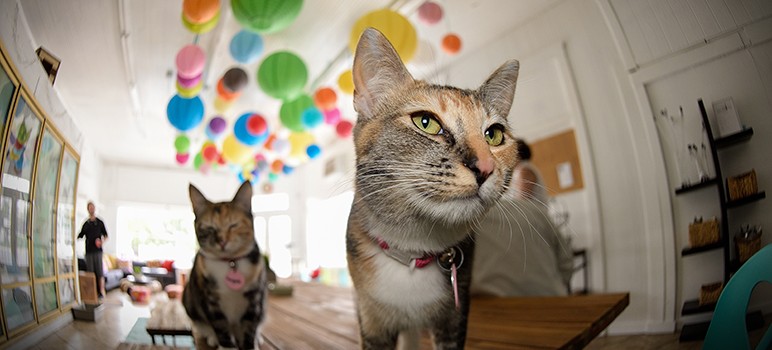
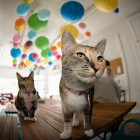
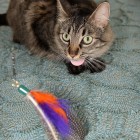
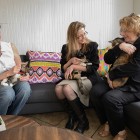
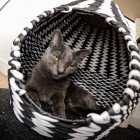
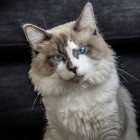

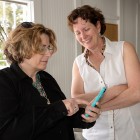
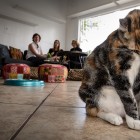
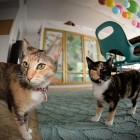
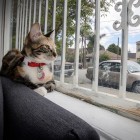
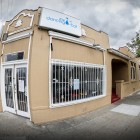
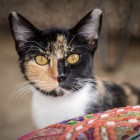
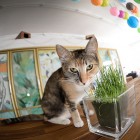
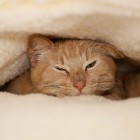
I’m posting this to reddit, right now, cause cats.
I can’t begin to express how wonderful this is. As a volunteer with cats, seeking a loving, compassionate forever home, this is a fantastic idea that is long overdue. My thanks and gratitude to the founders of this cafe and to all lovers of cats and future lovers of cats that will make this a successful operation. I just received two vouchers for Dancing Cat via an auction in support of the Wildlife Center of Silicon Valley and look forward to visiting with a cat loving friend. I also want to give a big MEEEEOOOOOW to Dancing Cat for their support of adoption programs for cats and for supporting the WCSV, a rescue, rehabilitation, and release hospital for sick, orphaned, and injured wildlife in this Valley of Heart’s Delight that is Santa Clara County.
We’ll look forward to your visit, Tangogato!
This is absolutely wonderful!
Thank you Jennifer for capturing the spirit of The Dancing Cat!
Cats, are and love. You’ve hit on the best combo, Mary. Indeed, the kitties deserve a chance for good homes. I’m “in” for a visit soon. And, thanks, too, to Jennifer Wadsworth for a very special story.
— Sharon Sweeney
Hey Jen,
Thanks for this article. I’ve pretty much read everything there is to read on the site, and this article for me harkens back to SJI’s original mood. Somebody needs to do the hard hitting stuff as well, but I sort of view websites like this as a soup, the more variety the better the taste. Thanks again!
I’m surprised they’d be closed two days a week. Someone has to be there to feed and otherwise keep an eye on the critters.
Hi Adrienne – we’re closed to the public two days a week to let the cats relax and introduce any new cats to the group. Our volunteers come in every morning seven days a week to feed, clean, and check on the cats, and we’re there every evening to do the same. Everyone is being well taken care of!
Can I volunteer! This is awesome I work for town cats but am unhappy with current status. Nedra
Nedra we’ll need lots of volunteers when we re-open! To see our open slots, check out the Silicon Valley Pet Project website here: http://www.svpetproject.org/info/display?PageID=15873
Personal opinion, time to close this site, seems only about 12 people care to reply to worthless posts. Just a thought?
WE DARE TO CARE TOBY. Really though, this site is pretty popular. You can’t judge it’s popularity based on who posts here. You gotta remember, at one point the City of San Jose was so fearful of this site that they banned it on the city firewall.
American Bird Conservancy is promoting Cats Indoors as part of their continuing habitat conservation efforts. It would be great if with every cat adoption you provide the pamphlets and information on the benefits to public health, wildlife, ecosystems and the cats themselves about keeping cats indoors. BTW Plenty of cats go outdoors safely on a leash. And, plenty of cats lead long happy, safe, healthy lives indoors, or indoors with access to a cat patio. Cat patios and enclosed cat porches can be works of art in themselves, as well as being safe healthy habitat for the cats.
These are going to be all indoor only cats, right? Safer for the cats, the birds, and the people, right? The American Bird Conservancy position: Domestic cats (Felis catus) can provide excellent companionship and make wonderful pets. But when allowed to roam outdoors, this non-native, invasive species threatens the welfare of birds and other wildlife and endangers the integrity of the ecosystems into which domestic cats are introduced.
Domestic cats are recognized as a threat to global biodiversity. Cats have contributed to the extinction of 33 species across the world and continue to adversely impact a wide variety of species, including those that are threatened or endangered. The ecological dangers are so critical that the International Union for the Conservation of Nature (IUCN) now lists domestic cats as one of the world’s worst non-native invasive species.
In the U.S., free-roaming domestic cats kill an estimated 1.4-3.7 billion birds and 6.9-20.7 billion mammals. The sheer quantity of cat-caused mortality is staggering. For perspective, consider that 1.4 billion is equivalent to the entire human population of China, the most populous country in the world. As the number of cats continues to grow and owners continue to allow their pets to roam, harmful impacts will surely increase.
The Dancing Cat is very happy to announce that we’ll be open for an additional couple of months. The community response has been tremendous and we’ve had over twenty cats adopted to wonderful homes. Stop by an say hello!